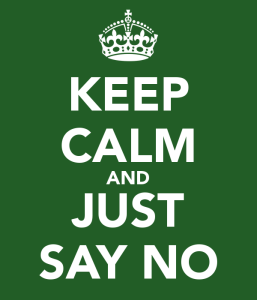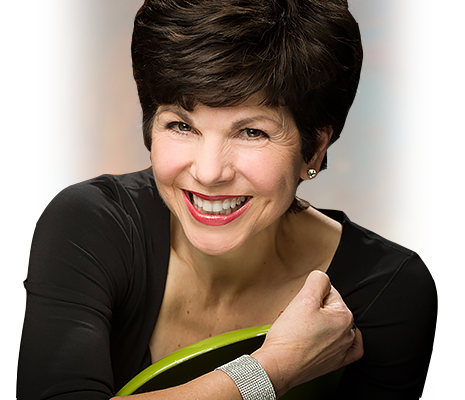 This week, I’ll be facilitating a discussion among a group of professional women on the topic of How to say ‘No’ with confidence, not guilt.
This week, I’ll be facilitating a discussion among a group of professional women on the topic of How to say ‘No’ with confidence, not guilt.
As it often goes with my speaking engagements, my topics and titles are created after listening to the needs of the meeting planners and their clients.
Kisha Zullo, who runs the WIB Summit (which stands for Women in Business), explained the situation where her female clients struggle when people “drop by” their office to chat when the clients are on deadline. How can you politely, but firmly, say “Go Away, I’m busy,” without negatively impacting the relationship? Or how about when you are at a networking event, and you feel trapped with one person who won’t stop talking. You know you need to mix and mingle and meet other people at this event, but you can’t find the right words to exit from the prolonged conversation.
The irony is that this topic, learning to say NO with confidence, is one that I need to hear myself. You see, this topic could very well could be the overarching theme of my life.
- As a child, I discovered early on that saying YES made me a popular people pleaser.
- As a young professional, saying YES when others said NO created exciting career opportunities for me, like working in the United Kingdom for three years as an expatriate for a global vision care company.
- As mature woman, saying YES to nonprofit board positions has opened up my eyes to global issues that need fixing and has strengthened my personal mission to empower women and girls, and to eliminate the violence and bias that holds back their incredible potential to lead.
Saying YES to everything has also cost me a great deal.
I remember one sobering moment when my beloved older brother David was dying of cystic fibrosis.* The last words he spoke to me were, “Poor Kathy. Always trying to please everyone else, never pleasing herself.” It took me another 14 years to figure out what the heck he meant. His last words were a wake-up call to my life. I am grateful for his love and wisdom…and enjoy sharing this powerful, personal story with others.
-
- *By the way, May is Cystic Fibrosis Month. Learn more about CF, an inherited chronic disease that affects the respiratory, digestive and reproductive systems of millions of children and adults. Learn more about the research and progress being made by the non profit organization, CFRI.
As a result of these experiences, I have become more aware that I have a choice in how I spend my time and energy. I am more conscious of my motivations for saying yes, which sometime include the negative but powerful emotions of guilt, shame, awkwardness, embarrassment, uncertainty, and peer pressure.
I had a therapist a number of years ago who told me that you can’t say YES until you learn to say NO. I’ve been practicing NO ever since.
Like most professionals that I know, I am concerned about raising my hand too often. Volunteering and saying YES every time anyone asks me to do something has depleted my coffers of energy, time, and sometimes money. But I am also aware that swinging the pendulum back to the default of NO seems a bit extreme. Yet this is what I see many people doing -saying NO just to survive the day and to protect themselves.
Invitation by Guilt
“There is a special place in hell for women who don’t help other women.” – Madeleine Albright
One of my least favorite “motivational” quotes is from Madeleine Albright, the first women to become United States Secretary of State. While I imagine that this quote was taken out of context, I still shudder when I hear women use this quote to rally and recruit other women to step up to volunteer for leadership roles. I find myself feeling compelled to add a phase to the end of her quote: “….and a special place in Heaven for those who do.” But even that phrase is a guilt-producing motivation.
Why can’t the invitation be sent and received without the guilt and other bad feelings?
Being willing to tolerate momentary discomfort to avoid long term resentment
Brené Brown, author of best selling books, The Gifts of Imperfection, The Power of Vulnerability, and Daring Greatly, offers solid advice to help us make more conscious choices. I remember her sharing a story of turning the ring on her finger at least 3 times while repeating a mantra before she said YES to anything.
As a storyteller and researcher of shame, Brené Brown has seen the negative impact that guilt and shame have on people. She believes that the powerful force of shame- which is fed by silence, isolation, and judgment – forces us to accept things that are not good for us, and to feel inadequate and bad about ourselves. We would rather say YES than to suffer the momentary discomfort of saying NO. Of course, saying YES to the wrong things for the wrong reasons only leads to resentment, unhappiness, stress, illness, etc.
Wait a minute….or 1,440 minutes.
While I do not practice the Brené ring-turning ritual, I do have a policy of a 24-hour wait period. I don’t say YES to anything big right away. Rather, I plan to hold my decision for a short time- even if I have a strong feeling that it is right for me. This gives me time to reflect, consider, sleep on it, etc.
- If I choose to say YES, then I know more about my decision – including my motivations, and expectations. I can enter the agreement with the full power of choice and awareness.
- If, after consideration, I feel that the best decision is NO, I can decline the opportunity with honesty, respect, and gratitude for being considered. Plus I also have time to plan my response.
Plan Your Communication
Prior to announcing your decision, spend time planning your communication. You may need to have a few “go-to” responses, so that you don’t feel awkward at the moment of the ask, or worse yet, reverse your decision under pressure.
Here are a few scripted replies that may come in handy. Practice saying them out loud. It will build your confidence.
- “Thank you, but no thank you.”
- “What a great opportunity. Unfortunately, I cannot partake at this time.”
- “Thank you for asking me. At the present moment, I have reached my limit of volunteer positions. But I do appreciate being considered. Good luck with your board recruitment.”
- Thanks for stopping by (or calling). I’d love to get caught up with you, but now is not a good time for me. Can you check back with me in a few days (hours)?”
- “Your event (cause, meeting, offer) sounds fabulous, but unfortunately I’m not able to support you at this time. Please keep me in mind for the future. Best of luck with your (event, meeting,etc.)
- “Your cause sounds wonderful and thank you for championing it. Unfortunately, my charitable giving dollars are fully committed this year and I won’t be able to help you out this time. I wish you great luck and success in meeting your goals.”
- “I would love to take notes for this meeting, but I think it would be more productive if everyone took their own individual notes.”
- “I’ve given your invitation careful consideration, and I’ve decided to decline at this time.”
- I appreciate, respect and value the opportunity you are offering, but it’s not right for me at this time. Thanks for understanding and respecting my decision.”
- “No.” ” Not now.” “Not yet.” “Not ever.”
- “What part of NO do you not understand? The N or the O?”
Okay, those last two scripted answers could get you into trouble. It’s best to be polite and respectful when you decline.
Give your answer in person or over the telephone
I also counsel you to, whenever possible, give your answer in person or over the telephone, rather than via email or text or other written communication. In this way, you are truly owning your decision with confidence. You can also use your vocal awareness to express your sincerity in the decision and concern for the relationship.
Of course, if you feel the other person may try to pressure you to change your mind or may use emotional tactics, it may be better to decline in writing. Always be ready to state your decision in person…without needing to defend your decision. It is YOUR decision. Your choice.
Avoid the Blame Game – Say What You Mean
When you say YES when you really want to say NO, you are denying yourself and setting yourself up for failure. The other day I was on the telephone with my neighbor and picked her brain about the topic of saying NO. She told me stories of her friends and clients who have said YES when they really meant to say NO, and how this has led to physical ailments, including migraines and stomach aches.
She mentioned that many people say YES when they want to say NO because of the pressure to play the good guy and to be liked. Societal norms motivate many of us to be nice at the cost of true selves.
When you knowingly enter into an agreement that is not in your best interests, you will inevitably feel resentment, anger, and bitterness. You will not be performing at your best. You are better off saying NO – which is what your gut is telling you to do.
NO is a complete sentence
“Avoid all language that divides and limits, that defines a winner and a loser, that pits an I against a you. This includes…the word NO.”-How to Say It (page 514)
I was surprised to see the word “No” on the list of 50 words to avoid in the book, How to Say It®, by Rosalie Maggio and Jack Griffin. I think this is crazy. NO is a power word and can and should be used frequently …and with respect.
NO is a strategic response that we learned at age of two. Why demonize it once we become high-functioning adults?
I believe that using the word NO can demonstrate your integrity, your values, your self care, and your self awareness. Saying NO to certain people and opportunities is a way of honoring and respecting your own personal boundaries and priorities. Saying NO can sometimes save your life – as in Just Say No to Drugs!
And while people may not like your decision to decline, they will find a way to respect you for it. Best of all, YOU will respect yourself for owning your truth.
Screw Guilt
Finally, I have one final bit of advice to help you decide whether to say YES or NO to any opportunity. It comes from my beloved Aunt Rosi. It’s wonderfully crass and really fun to say inside your head (i.e., think inner monologue, not verbalized). “Screw Guilt.” In just two words – both single syllable – you can level your thinking and remember that you are not obligated to do anything. Everything is a choice. You decide whether you choose YES or you choose NO. You have the power of consent.
Click to read Part 2 in this two-part blog>

